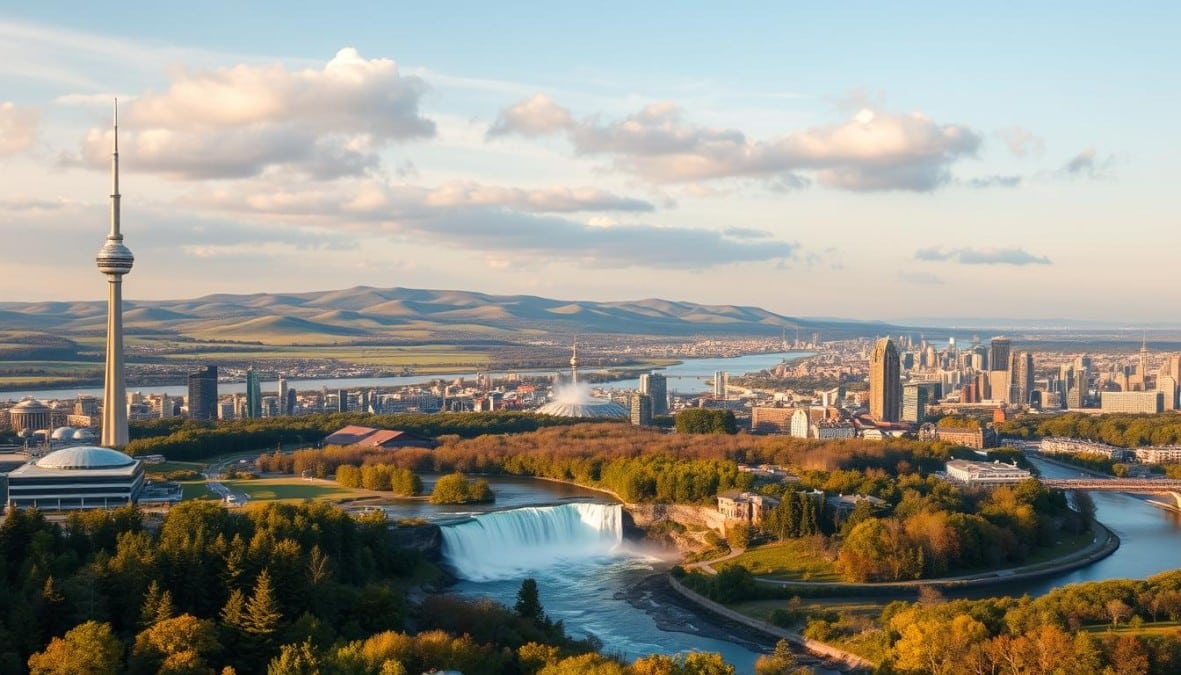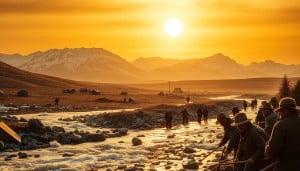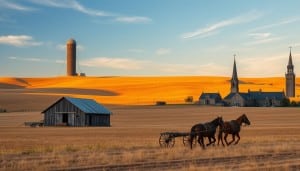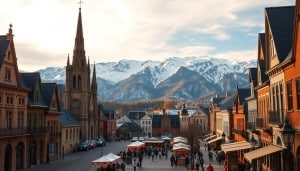Did you know Ontario welcomes over 250,000 newcomers every year? This adds to the diverse culture of this historic province. We’re going to look back at Ontario’s rich history. From its indigenous roots to becoming a multicultural province, Ontario has played a big part in Canada’s story.
Ontario has always been important in Canada’s history. In 1975, the Ontario Heritage Act was created. It helped to preserve Ontario’s story. Important places like St. Vital Roman Catholic Church show Ontario’s deep heritage and pride.
Ontario’s past shapes our community and Canada. Stories of resilience and unity highlight its spirit. Let’s honor Ontario’s role in Canadian heritage and unity. We look back to understand our path and move forward.
Early Indigenous Inhabitants of Ontario
We honor the deep Indigenous history of Ontario , vital for understanding the past. Long before European settlers, the land was cared for by groups like the Huron-Wendat Nation, the Anishinaabe People, and the Iroquois. Their rich cultures and advanced societies helped shape Ontario’s heritage today.
The Huron-Wendat Nation
The Huron-Wendat were experts in farming and trading, living in present-day Southern Ontario. They used clever agricultural methods and had a democratic way of life. These Ontario pioneers were crucial for the community’s survival. They led in trade and cultural exchanges in the area.
The Anishinaabe People
The Anishinaabe included the Ojibwe, Odawa, and Potawatomi tribes. They deeply valued their spiritual beliefs and nature. Their understanding of the land made them key partners in early European trade.
Iroquois Contributions
The Iroquois, especially the five Iroquois Confederacy nations, were strong in battle and diplomacy. They were known for their government structures, inspiring Western democracy. Their influence in Ontario was significant, leading to political and strategic developments.
The Indigenous peoples of Ontario ‘s rich legacy highlights their key role as the first residents and guardians of the land. They are the true pioneers of this diverse and flourishing area.
European Exploration and Settlement
Ontario’s history is rich with stories of European exploration. This era shaped the province we know today. Ontario first engaged with European cultures during this critical time. Samuel de Champlain’s voyages marked the beginning of this discovery period.
Ontario’s connection to French colonial times is strong, especially due to the fur trade. These routes were more than economic paths. They were ways of cultural and geopolitical exchanges that defined Ontario’s role in history.
The early economy built by European settlers and indigenous trade systems created a complex base. This foundation influenced important political and social choices in the area. Understanding these interactions helps us see how Ontario played a key role in historical agreements and treaties.
Ontario in the British Colonization Era
Ontario started changing under British rule with the Treaty of Paris in 1763. This was a key moment in Ontario’s history, bringing significant changes. Loyalists arrived, laying the foundation for Upper Canada.
The Treaty of Paris (1763)
The Treaty of Paris ended the Seven Years’ War and was a big deal for Ontario. It made France give up its North American lands. This kicked off a new chapter in Ontario’s history.
Loyalists and the Formation of Upper Canada
After the Treaty, many Loyalists came to Ontario from the chaos of the American Revolution. They helped start Upper Canada in 1791, a major part of Ontario’s history. These early settlers were key in shaping Ontario’s future.
The War of 1812 and Ontario’s Strategic Importance
The War of 1812 showed Ontario was very important to British North America. Places like Queenston Heights and York (now Toronto) were major battle sites. This time helped strengthen Ontario’s place in the Empire and its community.
The British colonization era was a big change for Ontario. It was a time that tested and proved Ontario’s strength, shaping its role in Canada. By remembering these events, we celebrate our past and are inspired for the future.
The Growth of Toronto
Toronto’s history is a vibrant part of Ontario’s culture. As the capital, it has helped shape Canada’s growth. It’s filled with landmarks and moments that are key to understanding Canada’s development.
![]()
When Toronto was named the provincial capital, it became Ontario’s heart. The city’s growth improved with better infrastructure. It turned into a bustling hub for business and government. These changes helped Toronto’s culture blossom in the 19th century.
| Year | Event | Impact on Toronto |
|---|---|---|
| 1834 | Incorporation as City of Toronto | Marked the official recognition of Toronto’s urban status |
| 1867 | Confederation of Canada | Strengthened Toronto’s role as an administrative powerhouse |
| 1897 | Opening of the Royal Victoria Museum | Enriched Ontario’s cultural landscape and education |
Key events have made Toronto a cultural hub and rich in arts. It stands as Ontario’s cultural beacon. A diverse population has made the city lively and beloved.
The History of Toronto is filled with significant moments. They’ve shaped the city and Ontario’s identity. Toronto’s historical and cultural fabric impacts everyone, inviting them to see its beauty and potential.
Railroads and Industrialization
The growth of railways was key in Ontario’s economic development history . The start of the Grand Trunk Railway got Ontario ready for big growth in business and industry. This time was crucial for Ontario to become a leader in economic growth.
The Impact of the Grand Trunk Railway
The Grand Trunk Railway joined far-flung communities. It also sparked industrial activities all over Ontario. It made moving goods and materials faster, boosting both the province’s and the nation’s economy.
Growth of Manufacturing Between the Wars
After World War I, Ontario saw its manufacturing grow fast. The strong rail network helped industries from textiles to cars expand. This attracted investments that were key for growth.
Immigration and Workforce Transformation
As industries in Ontario grew, the need for skilled workers rose. This led to a wave of immigration, making Ontario’s culture more diverse and its workforce bigger. Immigrants were vital in the industrial and social life of the province.
This time of industrial growth didn’t just shape Ontario’s economy. It also paved the way for future economic movements in Canada.
Ontario in the Post-War Era
The years after World War II were a turning point for Ontario. This time led to big changes and growth. The economic boom helped cities grow big, and new ideas in education and social changes made a big impact.
After the war, Ontario’s economy grew strong. This growth was due to more factory work and people buying more things. This set the stage for today’s busy city centers.
Ontario also saw big moves towards civil rights. These efforts were key in making society fairer. They showed how Ontario plays a big part in Canada’s push for progress. These changes not only reshaped how people connect but also how kids learn in school.
In education, Ontario made big changes. The goal was to ready young people for a new kind of economy. These new approaches helped spark creativity and deep thinking.
Now, let’s look at data that shows how much Ontario changed in its cities and schools:
| Year | Population Increase | New Educational Institutions | Legislation for Civil Rights |
|---|---|---|---|
| 1950s | 15% Increase | 20 New Schools | Civil Rights Act, 1954 |
| 1960s | 20% Increase | 30 New Universities and Colleges | Equality Act, 1962 |
| 1970s | 25% Increase | 35 New Schools | Human Rights Code, 1971 |
The numbers show quick urban growth and more schools. They also show laws for a fairer society.
This period was crucial for Ontario, leading to its strong base and growth. Today, we see its effects in lively cities, fair laws, and advanced education. This legacy lives on.
Ontario’s Natural Resources and Economy
Ontario has transformed greatly, thanks to its rich natural resources. These resources have been key to our economic growth. They support important sectors like mining, agriculture, and tourism.
Mining and Manufacturing Roots
Mining is vital to Ontario’s economy. Minerals like nickel, copper, and gold are mined here. They are sold around the world. Manufacturing turns these minerals into products. These products are then exported, making Ontario a major industrial player.
Agricultural Contributions to the Economy
Ontario’s soil is very fertile, which helps our farms thrive. Our farms produce a lot, like corn, soybeans, dairy, and poultry. These products are then sold inside and outside Canada. This helps our economy grow.
Tourism and its Economic Impact
Tourism is important to our economy too. Places like Niagara Falls and Toronto attract many visitors. These tourists help local businesses and show the world our culture. It makes our economy stronger.
Mining, manufacturing, agriculture, and tourism together keep Ontario’s economy strong. We value our past and aim for a sustainable future. We want to use our natural resources wisely to keep growing.
Environmental Changes and Conservation Efforts
Ontario shines because of its nature and commitment to keeping it healthy. Ontario’s environmental conservation mixes into both policies and how we all live. It aims to save our lush landscapes and waters. Every Ontarian plays a role in keeping our province pristine.
The Great Lakes’ well-being is key to Ontario’s environmental conservation efforts. They are home to many life forms and provide us with water, transportation, and fun. Fighting pollution and harmful species helps us all and shows we care about our community.
- The Great Lakes and Ecological Concerns
- Preservation of Natural Parks
- Climate Change Challenges
We also look after Ontario’s wide parks, where animals and plants find refuge. Our plans there aim to keep the area full of life for others to see later. Small or big, every step taken tries to help nature stay beautiful.
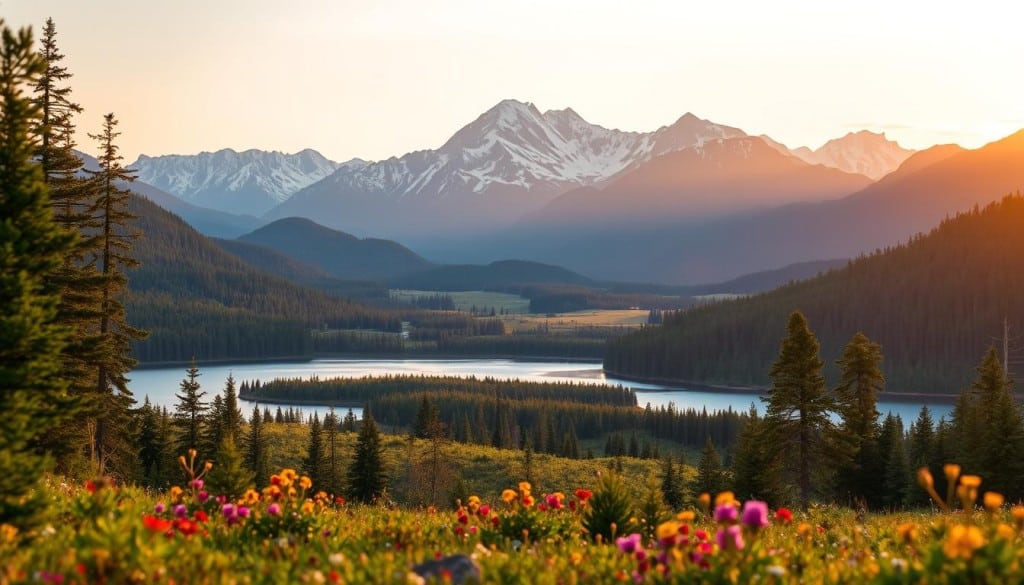
Dealing with climate change is tricky but crucial for Ontario’s environmental conservation . We’re stepping up to make Ontario strong by focusing on eco-friendly actions. This includes lowering emissions and using clean energy, which matches worldwide goals against climate change.
Every person in Ontario is asked to help our green efforts. Together, with our actions, awareness, and heart, we can make Ontario forever splendid. It’ll be an amazing place for many more years.
Ontario’s Cultural Identity
Ontario’s cultural tapestry shines through its diverse influences. Its festivals and artists showcase the rich nature of its society.
Ontario’s cultural heritage thrives with arts and events. Local artists’ works and multicultural festivals brighten cities. This shows Ontario’s cultural wealth.
Ontario blends history and modern culture uniquely. Let’s look at what makes Ontario’s identity special.
The Diverse Population of Ontario
Ontario is diverse and strong. You’ll meet people from everywhere, adding to Ontario’s culture. This diversity boosts empathy and innovation here.
Festivals Celebrating Multiculturalism
The Toronto Caribbean Carnival and the Ottawa Dragon Boat Festival highlight Ontario’s culture. These festivals bring people together, celebrating diversity and life.
Influence of Arts and Entertainment
In Ontario, arts and entertainment are key for cultural expression. They connect different ages and cultures. Events draw locals and visitors alike.
| Festival | Location | Month |
|---|---|---|
| Toronto International Film Festival | Toronto | September |
| Stratford Festival | Stratford | April to October |
| Caribana | Toronto | July to August |
Constitutional and Political Changes
Ontario’s history is full of key events like the Rebellion of 1837 and Confederation of 1867. These events changed Ontario’s political scene. They explain Ontario’s big role in Canadian politics today. Let’s look at these important times that changed how Ontario is governed.
The Rebellion of 1837 showed how people in Upper Canada wanted change. They fought against colonial rule to have their voices heard. This struggle helped Ontario move towards self-rule.
Then came the Confederation of 1867, a big moment for Ontario. As a founding province, Ontario helped shape Canada. It argued for a system that balances provincial rights with a strong central government.
| Historical Event | Date | Significance |
|---|---|---|
| Rebellion of 1837 | 1837 | Triggered a push towards responsible government in Upper Canada. |
| Confederation of 1867 | 1867 | Established Ontario as a founding province of the Dominion of Canada, shaping the federal structure. |
Ontario keeps playing a key role in shaping Canadian policies. It continues to affect how the nation is governed. By knowing Ontario’s political past, we can see its strong influence. This helps us understand its impact on Canada’s present and future.
Education and Innovation in Ontario
In Ontario, education and innovation go hand in hand. The province’s schools and universities have evolved. They now blend traditional methods with the latest technology. This mix has led to big achievements in education.
Our focus on improving education is clear in every classroom and campus. Schools and universities keep adapting. They aim to serve our students’ present and future needs well.
Evolution of the Education System
Education in Ontario has changed a lot over time. Classes now use digital tools. And learning can be tailored to each student’s needs. This prepares them for a fast-changing world.
Research and Technological Advancements
Research is key to our educational success. Our research centers and universities lead in cutting-edge fields. They explore artificial intelligence, biotech, and green energy solutions.
Public Libraries and Literacy Efforts
Ontario’s public libraries play a big role in our literacy programs. They offer many resources and run programs. These programs encourage lifelong learning and help the community come together.
| Year | Initiatives | Impact |
|---|---|---|
| 2015 – Present | Expansion of digital learning tools in classrooms | Enhanced student engagement and learning outcomes |
| 2018 – Present | State-funded research grants in clean energy | Advancements in eco-friendly technologies |
| 2020 – Present | Implementation of community literacy programs | Increased literacy rates and community involvement |
Our dedication to growth makes Ontario a leader in education and innovation. We’re creating a future that is bright and full of possibilities. This effort helps our citizens grow intellectually and keeps Ontario innovative.
The Future of Ontario
As we look towards the future, Ontario shines with potential. This province, Canada’s heart, is at the brink of a new chapter marked by Ontario’s economic and sustainable future . We see a province growing strong, overcoming obstacles, and building on shared goals.
Economic Trends and Projections
Ontario’s economy is on the rise, with strong growth ahead. Innovation drives us, and our community’s hard work powers our nation’s economy. With diverse talents and a solid industry, we’re ready for a future of wealth.
Embracing Diversity and Inclusion
Ontario’s strength comes from our mix of cultures and being open to everyone. We believe in lifting everyone up, knowing this makes us stronger. Our goals for a future of diversity and inclusion are realistic and key for a united society.
Sustainable Development Initiatives
For us, sustainable progress is crucial. We’re working on projects for Ontario’s economic and sustainable future today. Focusing on green tech, protecting nature, and using resources wisely, we aim for growth that cares for our planet and its people.

